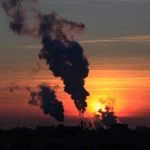First of all: what are greenhouse gases?
Let’s start at the beginning. Greenhouse gases such as CO₂ and methane are components of our atmosphere and therefore part of the air we breathe. This air normally consists mainly of nitrogen (79%) and oxygen (21%). Less than 0.1% of the atmosphere consists of greenhouse gases. Less than 0,1% raises the question if it is really so bad if it gets a little higher? The answer is yes. Compare it to the time you added a small hot pepper to your big pan of green curry. The pepper may be small, but it can easily make you sweat at the dinner table.
But, as with everything in nature, these gases have an important purpose, and we are lucky to have them. Without greenhouse gases, the average temperature on Earth would be about 32 degrees Celsius colder than it is today. Depending on the geographical location, the average temperature would be between 14 and -18 degrees. So actually, we’ve got to thank greenhouse gasses for the warmth on earth. But if fewer greenhouse gases means colder temperatures, then more greenhouse gases means warmer temperature. In other words, the earth is warming up.
A hotter planet, due to our own emissions
At the end of the 18th century, the motor was invented. This marked the start of the industrial revolution. The power of machines and engines brought about major changes. Mass production, consumption, construction and transport took place. Without this revolution, life around the world would have looked completely different to how it does today, but it is also the reason for an extreme increase in CO₂ in the atmosphere.

The amount of co2 in atmosphere over time
For thousands of years the amount of CO₂ was stable, but since 1750 the amount of CO₂ in the atmosphere has increased by almost 50%. The amount of methane in 2011 was already 150% greater than in 1750. Because we have been extracting and burning fossil fuels since the industrial revolution, the amount of greenhouse gases in the atmosphere has been rising explosively.
These fossil fuels embodying millions of years old organic matter contain carbon, which after burning enters our atmosphere as carbon dioxide (CO₂). So it takes millions of years for organic material to convert into fossil fuels, but we burn it all in a few centuries. This sudden release of CO₂ and other greenhouse gases cannot possibly be absorbed by plants and trees in such a short time. All the more so because we are cutting down forests all over the world at breakneck speed, mainly for agriculture and cattle breeding.
How do greenhouse gases warm the earth?
In short: greenhouse gases absorb heat and reflect solar radiation. Once sunlight reaches the atmosphere, it is “broken down” by greenhouse gases into smaller solar rays. Some of it is reflected directly into space, but most of the sunlight travels through the atmosphere and reaches the Earth’s surface. From the Earth’s surface it bounces back, but on its way back it as well encounters the greenhouse gases, by which it is reflected again. This process repeats itself. So the solar radiation is kept inside the atmosphere longer by the greenhouse gases, causing the earth’s surface and atmosphere to warm up.

How do greenhouse gases contribute to climate change?
Life on a hot planet
We are already seeing the effects of our emissions on the climate. The increase in extreme and fluctuating weather, droughts, floods, hurricanes, are all a result of global warming. On our planet, everything is perfectly interconnected to allow humans, other animals and nature to flourish. However, this balance is also vulnerable. The change of one part of this immense, interdependent web can have a domino effect and ultimately affect areas that at first glance seem completely unconnected.
Global warming does not necessarily mean warmer temperatures everywhere. But global warming does influence wind and water currents and so, causes the changing climate we are already experiencing. There is also a big difference in how the warming is distributed. Whereas the equator is warming by one degree, the North and South Poles are warming by 12 degrees. You don’t need to be a scientist to realise that a 12 degree warming is not good for an ecosystem with snow and ice.

How much has the temperature risen due to global warming?
Many ecosystems, such as coral reefs, are much more sensitive to temperature changes than, for example, humans. These types of ecosystems are slow to adapt to environmental changes. Coral reefs are already bleaching around the world, which is disastrous for marine life.
All the consequences of the human made climate change, such as melting ice caps, the desertification in Africa, or the deforestation of rainforests, have serious effects for life all over the world. Animal and plant species die out, people have to migrate because large areas become uninhabitable while decreasing resource availability causes conflicts, viruses and diseases spread faster, harvests fail and forest fires occur more frequently.
What can we do?
The answer is quite simple: reduce our greenhouse gas emissions. We need to stay below 1.5°C warming to avoid the worst impacts of climate change (1) and for that countries need to become climate neutral/zero emitters. Consumers, governments and businesses all have a role to play in this. We, at Enie do this, for example, by committing to become fully carbon neutral by 2030. The first step for that was offsetting our own emissions since inception.
Together, we are making a difference by no longer burning fossil fuels, but using the endless, clean alternatives we have. For nature, the sun has always been its greatest supplier of energy. It is our cleanest and most accessible source, provides the most energy and is the core of life on earth. We can make the sun the biggest energy source again within ten years. Are you with us?







